An album of commemorative monuments and statues in Hongo and Komaba

An album of commemorative monuments and statues in Hongo and Komaba
In the order of their creation
60 monuments left to us by our pioneering predecessorsThere are numerous monuments and statues around campus celebrating the history of the University. You may have walked past them or spotted them on a map (without much thought), but have you ever seen them laid out chronologically in one place? Here, we present to you 60 monuments from both Hongo and Komaba campuses that have survived to this day thanks to the strong intentions of those before us.
Hongo – Edo period
Stone Wall along the Sanjo Conf. Hall
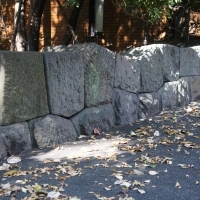
This early-Edo period stone wall was excavated during the construction of the Hall, and put back together in its current location. Carvings matching those engraved in the walls of Kanazawa Castle can be found on some of the stones.
Hongo – Edo period
Higashi-onagaya Drainage Outlet
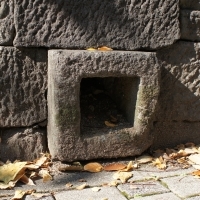
In the foundation of the wall located behind the Lawson Tatsuoka Gate Store, there remains a drainage outlet of a row house (nagaya) on the east side where low-ranking samurai lived.
Hongo – Edo period
Higashi-onagaya Well
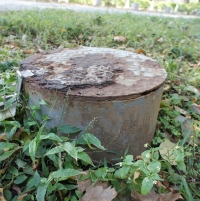
There are remains of a well by the sidewalk in front of the Lawson Tatsuoka Gate Store. This well used to be in front of a row house, and was included in a picture diagram of Kaga Domain Edo residences.
Hongo – Edo period
Hebizuka (Haunted Lantern)
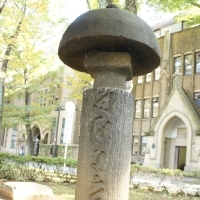
Located in the square around the Faculty of Engineering buildings, this is thought to be a memorial for a maid who was tortured and killed with vipers as punishment for her misconduct (truth not verified). It is said that bad luck will come to those that move it…
Asano – 1828
Mukaigaoka-no-ki Monument
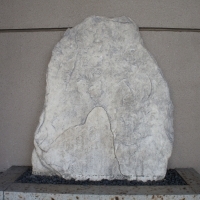
Placed by Tokugawa Nariaki in the second residence of the Mito Domain. The inscription “Yayohi” (夜余秘) is the origin of the name for the Yayoi area. It is on the hill as you enter the Asano South Gate.
Hongo - 1833
Ikutokuen Hilltop Monument
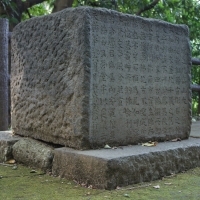
This is a monument commemorating the enshrinement of Buddha in the Toyama Domain residence (current University Hospital area). The reason why it was moved to its current location, where the Kaga Domain residence used to be, is unknown.
Hongo – 1893
Erwin Bälz’s Garden Stone
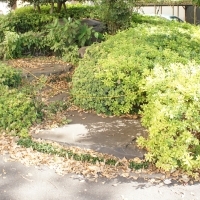
This stone was in the garden of the Toyama Domain daimyo yashiki (feudal lord mansion). Professor Bälz lived next door in the residence for professors and cherished the garden, hence the name of the stone. Located in front of Inpatient Building A.
Hongo - 1895
Bust of Leopold Müller
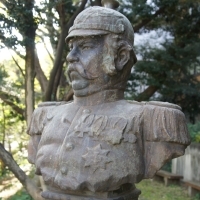
Professor Müller taught the likes of surgery and ophthalmology. The original bust was erected by his students; it was stolen but was eventually reconstructed in 1975.
Hongo – 1900
Bust of Edward Divers
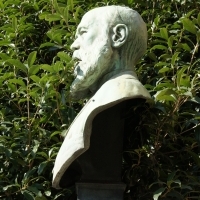
Professor Divers was given the title of Emeritus Professor for laying the foundation of chemistry education in Japan. His bust was relocated and is now situated by the Faculty of Science Chemistry Building.
Komaba – 1900
Tōgū Keirei Kinen-no-Matsu Monument
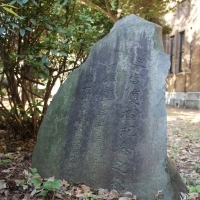
When Emperor Meiji’s third prince (Prince Yoshihito) got married, the First Higher School students planted a pine tree along with this stone monument. It is unknown when the tree was relocated.
Yayoi - 1902
Bust of Johannes Janson
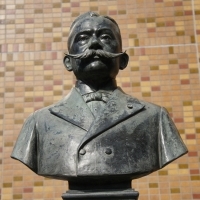
Professor Johannes Janson contributed greatly to education in the field of veterinary medicine at the veterinary hospital in Komaba. This bust, commemorating his being named Emeritus Professor, was later moved to Yayoi.
Komaba – 1902
Bust of Jean-Baptiste Arrivet
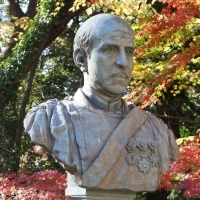
Professor Jean-Baptiste Arrivet contributed to French language education at the First Higher School. The bust was moved to Nagano to keep it safe during the University of Tokyo Protests (Todai funsō), and was brought back in 2004.
Komaba – 1902
Bust of Friedrich Putzier
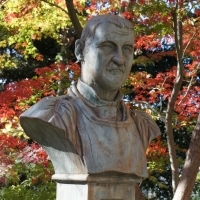
Professor Friedrich Putzier taught German at the First Higher School. His bust was erected in Mukōgaoka upon his death, and was later moved to Komaba (as with Professor Arrivet’s bust).
Hongo – 1907
The Foundation of Marquis Maeda’s Western-style Residence
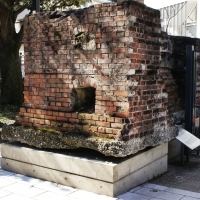
The residence that later became the Kaitokukan was destroyed during the air raid in 1945. This foundation was excavated when the University Museum was expanded, and was preserved right by the Kaitoku Gate.
Hongo – 1907
Bust of Erwin Bälz
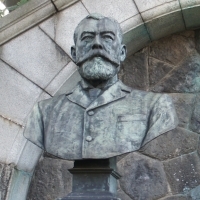
Dr. Erwin Bälz practiced internal medicine, obstetrics and gynecology in the Faculty of Medicine. His 25th year employment anniversary party was held at the Koishikawa Botanical Garden.
Hongo – 1907
Bust of Julius Scriba
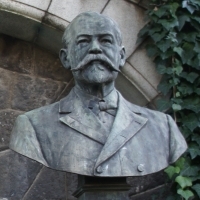
Dr. Julius Scriba was a surgeon, and used the kanji 須栗場 (su-kuri-ba) for his name. He watches over the hospital along with Dr. Bälz’s bust.
Hongo – 1910
Bust of Charles West
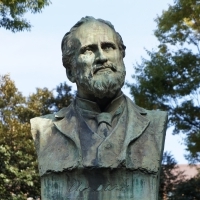
Professor West taught mechanical engineering and naval architecture. There are reliefs of technical drawing tools, machinery, and a shipyard on the base of the bust.
Hongo – 1911
Monument Commemorating Emperor Meiji’s Imperial Visit
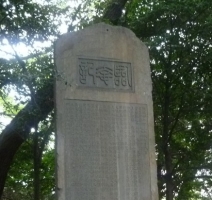
The monument, commemorating the Imperial visit in 1910, is located on the artificial hill in the Kaitokukan Garden. The Garden was designated as one of Japan’s National Places of Scenic Beauty (名勝) in 2015, and is open to the public on Homecoming Day.
Yayoi – 1912
Monument to Zhu Zhiyu (Shunshui)
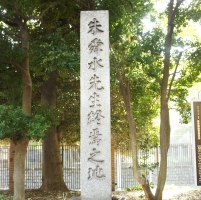
Zhu Zhiyu, a Confucian scholar who was a surviving retainer from the Ming dynasty, was invited to the Mito Domain’s second residence by Tokugawa Mitsukuni. This monument commemorates the 250th anniversary of his visit, and is located near the footbridge.
Hongo – 1914
Statue of Miyoshi Shinrokuro
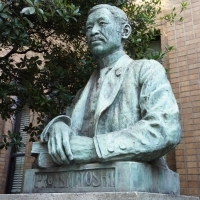
He became a professor at the newly established shipbuilding department of the Imperial College of Engineering upon his return from his studies in Britain. He is holding a book called “Manual of Naval Architecture” in the statue.
Hongo - 1915
Bust of Shimoyama Junichiro
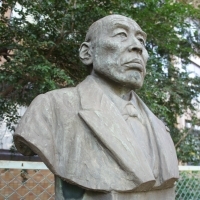
When he returned from his studies in Germany, he became a professor of the newly established pharmaceutical department of the Medical College. He was the first person in Japan to achieve a doctorate in pharmaceutical sciences, and his bust is to the side of the Pharmaceutical Sciences Research Building.
Hongo – year of creation unknown
Bust of Kumagawa Muneo
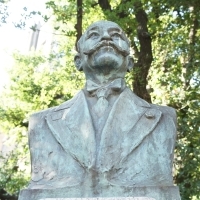
Upon his return from his studies in Germany, he became a professor of the Medical College, and a pioneer of biochemistry in Japan. This bust, with a relief of chickens on its pedestal, is located behind the Faculty of Medicine Building 2.
Hongo – 1920
Bust of Aoyama Tanemichi
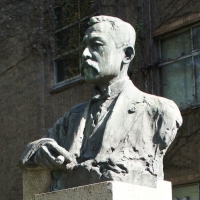
Upon his return from his studies in Germany, he was put in charge of internal medicine at the Medical College, where he served as the president for 16 years. The bust is located along the bus route.
Hongo – 1922
Statue of Josiah Conder
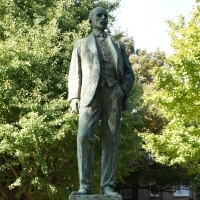
Professor Josiah Conder engaged in architectural education and design starting in 1877. The pedestal features demons at its base, which support the standing statue located in the square in front of the Faculty of Engineering.
Hongo – 1924
Bust of Sato Sankichi
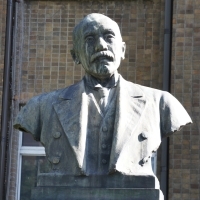
He served as the director of the University Hospital as well as the president of the Medical College. The bust features Dr. Sankichi mid-surgery, and is located next to the bust of Dr. Aoyama, with whom he went to study abroad.
Hongo – 1928
Stone Monument Commemorating the Origin of the Himalayan Cedars
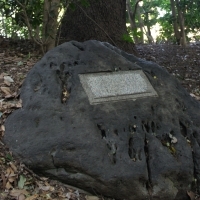
By the order of President Hamao Arata, 300 Himalayan cedar trees were planted on campus in 1907. This monument commemorates the one tree that remains, which still thrives to this day right behind President Hamao’s statue.
Hongo – 1932
Statue of Hamao Arata
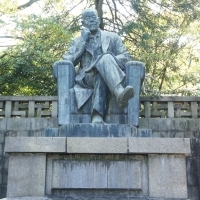
President Hamao served in office twice for a total of 11 years and 3 months. He is father to the iconic avenue of ginkgo trees, and his statue is the biggest on campus. He sits with the pond to his back, gazing at the Yasuda Auditorium.
Komaba – 1933
Kanran (Olive) Stone Monument
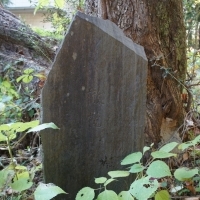
The monument was inscribed by Professor Saitō Agu of the First Higher School. He brought an olive tree back from Europe, and it was initially planted in Mukōgaoka. It was then moved to Komaba, and the stone monument was placed next to it.
Hongo – 1935
Professor Sagara Tomoyasu (Chian) Memorial Monument
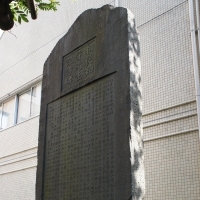
Professor Sagara laid the foundations of the Faculty of Medicine when, as an investigator designated by the government to research modern medical systems, he suggested that Japan adopt a German-style practice. The monument was moved to the front of Inpatient Building A in 2007.
Yayoi – 1935
Kōryō-hi Monument
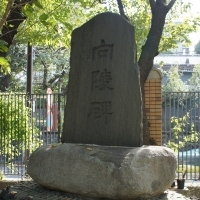
This monument marks the relocation of the First Higher School. The farewell message engraved reads: “Oh Kōryō, your spirit will be forever with my school.”
Komaba – 1935
Statue Built to Honor Professor Shiba Chūzaburo (Monument to Aeronautics)
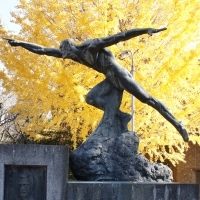
This “aeronautical” statue was built to honor Professor Shiba, head of the Aeronautical Research Institute, who contributed greatly to the relocation of the Institute to Komaba. This dynamic statue is the work of Yoshida Saburō.
Komaba – 1936
Komaba Agriculture Monument
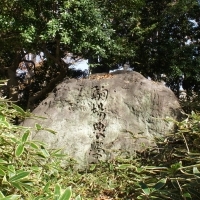
Upon the Faculty of Agriculture’s land exchange with the First Higher School, this monument was placed to mark the birthplace of agricultural science in Japan. The engraving is in the writing of Professor Takahashi Teizō, who was the dean of the Faculty of Agriculture.
Hongo – 1937
Statue of Furuichi Kōi
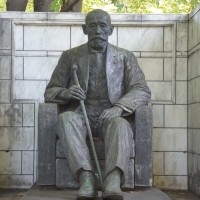
Professor Furuichi, a leading figure in the civil engineering world, was the first head of the Technical College (now the Faculty of Engineering) and was the first in Japan to receive a doctorate in engineering. The statue sits on the edge of Hongō-dōri Avenue, staring intently at the Faculty of Engineering.
Hongo – 1941
Autopsy Table Memorial
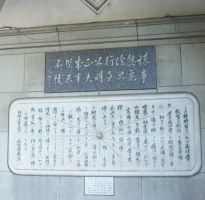
The actual table is embedded in the wall by the east entrance of the Faculty of Medicine Building 2. Upon their deaths, both Professor Miura Moriharu and Professor Yamagiwa Katsusaburō from the Department of Pathology spent time on this table as they donated their bodies to science.
Komaba – 1958
“Ah-gyokuhai” Monument
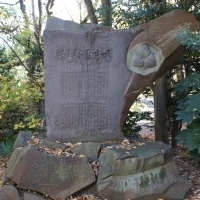
This monument of the First Higher School’s notable dormitory song “Ah-gyokuhai” (“Oh, Jade Cup”) was built by a group of alumni. It is located in the Faculty House garden.
Yayoi – 1974
Cenotaph for Animals
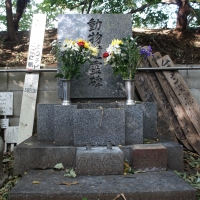
Behind the Veterinary Medical Center (former Veterinary Hospital) is a monument honoring deceased animals. Sentiments of the owners resonate from the sotoba (wooden grave tablets).
Asano – 1976
Yayoi 2-chōme Archaeological Site
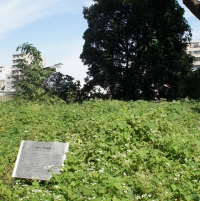
In 1884, ancient pots were discovered near the Nezu valley. These relics were later named Yayoi pottery after the region name, and the whole area was designated a National Historic Site.
Hongo – 1981
Mizuhara Shūōshi’s Haiku Monument
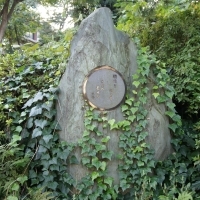
Kyōzō wo, nurasu nihon-no, hana-no ame (Japanese flower petals fall on the bust like raindrops). Mizuhara, a haiku poet and a graduate of the Faculty of Medicine, wrote this haiku while thinking about Dr. Bälz, who contributed greatly to Japanese medicine.
Hongo – 1981
Medical Library 20th Anniversary Commemorative Plaque
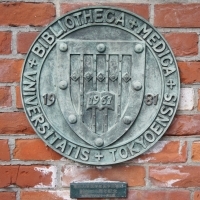
This relief with the Faculty of Medicine crest as its motif is on the brick wall along the Museum of Health and Medicine (currently closed in preparation for its move in April 2019).
Yayoi – 1983
Monument to the Birthplace of Seismology
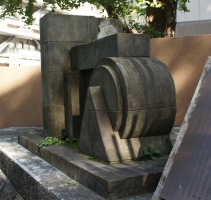
This monument features a seismometer-shaped art piece that used to be in the Earthquake Research Institute’s former building in the Hongo Campus. This was later placed by the main gate of the Institute together with a time capsule in 1988.
Asano – 1986
Yayoi Pottery Excavation Monument
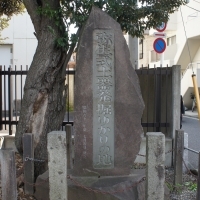
This stone monument was built by volunteers from the local neighborhood association, and it is located in between Kototoi Dōri and the Asano Section, which owes its origin to the Asano family that took over a part of the Mito Domain.
Hongo – 1986
Professor Yamaguchi Kichirō’s Haiku Monument
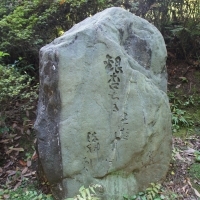
A professor of mining engineering and a haiku poet, Professor Yamaguchi also went by the pseudonym Seison. The haiku engraved reads: ichō chiru, mattadanaka-ni, hōka ari (the law school stands right in the middle of the falling ginkgo leaves). This was written around the time when the war between Japan and the US broke out.
Komaba – 1996
Yanaihara-mon Gate Site Monument
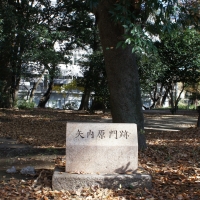
The gate was named after Yanaihara Tadao, the former dean of the College of Arts and Sciences (as well as the president of the University), who went through this side entrance that leads to the shopping district. Only the monument remains today.
Yayoi – 1998
Monument Marking the Former Site of the Daishōji Domain Daimyo’s Edo Residence
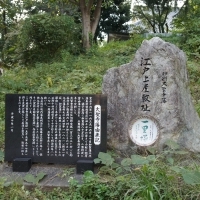
Maeda Toshitsune, the third daimyo of the Kaga Domain, divided up the land and handed a part down to his third son, Maeda Toshiharu, which became the Daishōji Domain. There is a decorative Kutani-yaki plate on the monument marking the former site of the Domain’s Edo residence; Kutani ware owes its origin to Toshiharu.
Hongo – 2002
Ikutokuen Shinji-ike (Sanshirō Pond) Stone Monument
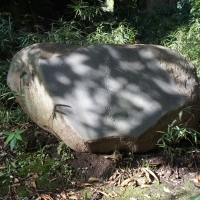
The engraving Kyū- Kaga-han Kamiyashiki Ikutokuen Shinji-ike (Ikutokuen heart-character-shaped (心) pond at the former Edo residence of the Kaga Domain) is in the handwriting of Maeda Toshiyasu, the 18th head of the Maeda family. It is located to the right as you enter the pond area.
Hongo – 2003
Tree Planted to Honor Koshiba Masatoshi (Chinese Pistache)
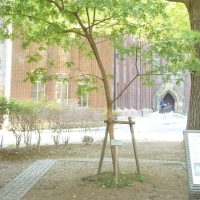
This tree was planted to commemorate Professor Koshiba’s winning of the 2002 Nobel Prize in Physics. The seed of this tree originates from the Temple of Confucius in China, and it is steadily growing outside the Faculty of Science Building 1.
Komaba – 2004
“Ichikō koko ni ariki” (Here is the First Higher School) Stone Monument
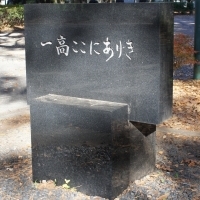
This monument was placed to mark the official end of the First Higher School alumni association’s activities. It stands boldly to the left as you enter the Main Gate, embodying the Kōryō spirit.
Komaba – 2004
Relief Honoring Professor Frederick Strange
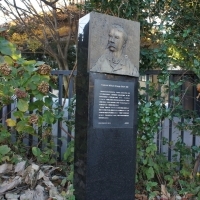
Professor Strange is the father of modern sports in Japan, having introduced a number of sports in addition to his contributions to English language education. The relief is located by the athletic field.
Komaba – 2004
Site of the First Higher School’s Student Residence Halls
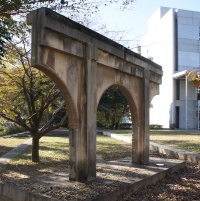
The First Higher School student residence halls continued their self-governance after they were moved to Komaba from Hongo. Part of the outer wall of one of the entrances to the halls’ underground passageway remains.
Hongo – 2005
Arima Akito Haiku Monument
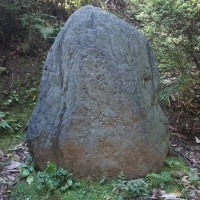
A former president of the University as well as a haiku poet, Professor Arima’s poem expresses the values of peace and academia alongside the haiku master Seison’s (Professor Yamaguchi’s) monument. The engraved haiku reads: Ichou chiru, mangan-no-sho no, page (pe-ji) yori (the ginkgo leaves fall on the pages of the many books).
Hongo – 2006
Bust of Yamakawa Kenjirō
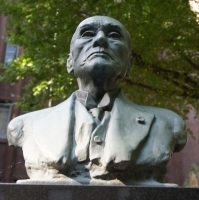
The former president was once a Byakkotai (“White Tiger Force”) member, and was known as seiza no hito (“constellation man”) for his ability to guide others. This bust was a donation from his great grandchild and their descendants, and is located in front of the Faculty of Science Building 1.
Yayoi – 2007
Tree Commemorating the 70th Anniversary of the UTokyo Baseball Ground
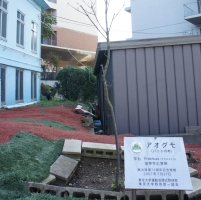
Hamada Junichi, the then-executive vice president who later went on to become the president of UTokyo, planted this Japanese ash (Fraxinus lanuginosa) tree by the baseball ground. This type of tree is often used to make baseball bats, and has grown more than three times in size since it was planted.
Hongo – 2008
University Nursing School and Midwives School Memorial
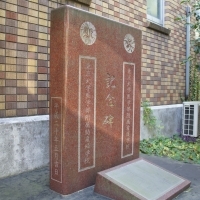
Both schools with a long history, belonging to the Graduate School of Medicine and Faculty of Medicine, closed in 2002. This monument is placed in front of their former building, the current Faculty of Medicine Building 5, with the schools’ emblems and songs engraved.
Komaba – 2008
KONOHA bench
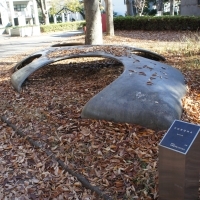
This leaf-shaped bench was a gift from the Japan Kanji Aptitude Testing Foundation as part of the 130th anniversary of the University. It is located behind the auditorium.
Hongo – 2009
Graduate School of Medicine and Faculty of Medicine 150th Anniversary Monument
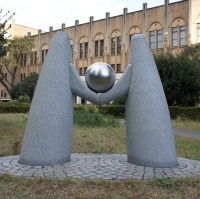
This piece was selected among many student entries. It is in an “M” shape for “medicine” formed with two bodies facing one another supporting a sphere. It is located in front of the Faculty of Medicine Building 2.
Komaba – 2009
Relief of Emblem on “Gokokuki,” the First Higher School’s Flag
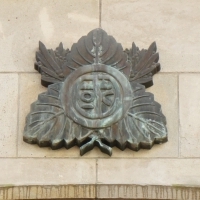
The emblem is composed of kanran (olive) leaves, representing academics, and oak leaves, representing athletics, with the old kanji for “country” (國) in the middle. This relief is placed on the arcade behind Building 1.
Komaba – 2009
Niihari Monument
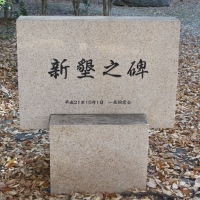
Monument memorializing the song composed for the 47th dormitory anniversary festival, “Niihari-no kono oka-no ue,” which was also known as Komaba-no-gyokuhai (Komaba’s “Jade Cup”). It was placed in Yanaihara Park by the First Higher School alumni association.
Hongo – 2010
Monument Marking the Tree Planted in Memory of Ume Kenjirō
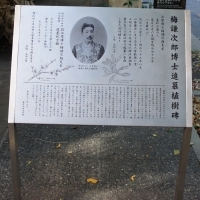
A Japanese ternstroemia (Ternstroemia gymnanthera) was planted three times in memory of Ume Kenjirō, who contributed greatly to the Civil Code, in time for the 100th year anniversary of his death. It is placed by the pergola along Hongō-dōri Avenue.
Yayoi – 2011
Stone Monument Marking the Mukōgaoka Dormitory
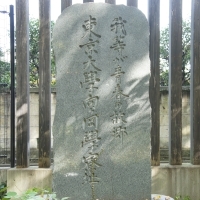
The dormitory, which was built in 1949, shut its doors in 2003. Former dormitory students placed this monument in the courtyard after the building reopened as the Mukōgaoka Faculty House.
Yayoi – 2015
The Statue of Professor Hidesaburo Ueno and Hachiko
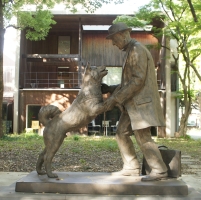
This monument was built by a group of volunteers who were concerned that not many knew that the guardian of Hachiko was a UTokyo professor. The pair seems delighted to be reunited in Yayoi.
*There are many other statues and monuments at the University of Tokyo that have not been featured in this article.
Note: This article was originally printed in Tansei 36 (Japanese language only). All information in this article is as of March 2018.






